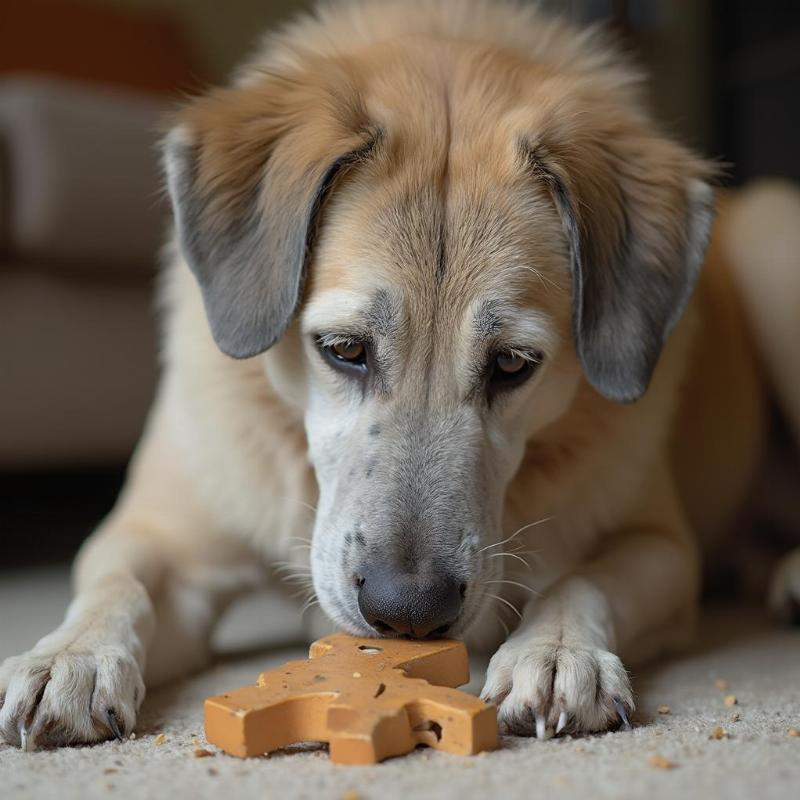When Is A Dog Geriatric? This is a question many loving dog owners begin to ask as their furry friends enter their golden years. Understanding the signs of aging and knowing when your dog is officially considered a senior is crucial for providing the best possible care during this special stage of life. It’s about more than just grey hairs and slower walks; it’s about adapting our care to meet their evolving needs.
Similar to at what age are dogs seniors, there isn’t a single magic number that defines when a dog becomes geriatric. It’s more of a gradual transition than a sudden shift, and it varies based on breed, size, and individual health history. While smaller breeds tend to live longer and enter their senior years later than larger breeds, general guidelines suggest that large breed dogs are considered seniors around 6-7 years old, while smaller breeds might not reach senior status until 10-12 years. Recognizing the subtle changes that accompany aging will help you support your beloved companion as they navigate this stage of life.
Understanding the Aging Process in Dogs
Several factors contribute to a dog’s aging process. Genetics play a significant role, as certain breeds are predisposed to specific age-related health issues. Lifestyle, including diet and exercise, also has a major impact on how a dog ages. A balanced diet and regular, appropriate exercise can help maintain muscle mass, joint health, and overall well-being in senior dogs.
Signs Your Dog is Entering Their Geriatric Years
Identifying the signs of aging is essential for understanding when your dog is becoming geriatric. These signs can be subtle at first, but they become more pronounced as your dog ages. Some common indicators include decreased energy levels, changes in sleep patterns, stiffness or difficulty moving, weight changes, changes in coat quality, and changes in cognitive function, such as confusion or disorientation.
 Senior Dog Sleeping Peacefully
Senior Dog Sleeping Peacefully
Just as with humans, aging in dogs can bring about changes in sensory perception. Their eyesight and hearing may diminish, making them less responsive to visual and auditory cues. This is similar to what age is a senior dog considered, as these changes often coincide with the transition to seniorhood.
Providing the Best Care for Your Geriatric Dog
Once you recognize that your dog is entering their geriatric years, adapting their care to their changing needs is crucial. This encompasses various aspects, from diet and exercise to mental stimulation and veterinary care.
Adapting Diet and Exercise
A senior dog’s nutritional needs differ from those of a younger dog. They may require a diet that is lower in calories but higher in fiber and certain nutrients to support joint health and cognitive function. Regular, low-impact exercise is essential for maintaining muscle mass and preventing stiffness, but it’s important to avoid overexertion.
Addressing Cognitive Decline
Cognitive decline is a common occurrence in geriatric dogs. Providing mental stimulation through interactive toys, puzzles, and gentle training can help keep their minds sharp. Maintaining a consistent routine can also provide a sense of security and reduce anxiety.
 Senior Dog Engaging with a Puzzle Toy
Senior Dog Engaging with a Puzzle Toy
Regular Veterinary Checkups
Regular veterinary checkups become even more important as your dog ages. Early detection and management of age-related health issues can significantly improve their quality of life and extend their lifespan.
This is similar to at what age a dog is considered senior, as regular veterinary checkups are recommended for all senior dogs to ensure their health and well-being.
Dr. Emily Carter, DVM, emphasizes, “Regular veterinary visits are essential for geriatric dogs. Early detection of health issues allows for timely intervention and can significantly improve a dog’s quality of life in their senior years.”
Embracing the Golden Years
The geriatric years are a precious time to cherish the bond you share with your beloved companion. While aging brings challenges, it also offers a unique opportunity to deepen your connection and provide the extra love and care they deserve.
Creating a Comfortable Environment
Creating a comfortable environment for your geriatric dog is paramount. This includes providing a soft, supportive bed, ensuring easy access to food and water, and minimizing potential hazards in the home. Maintaining a consistent routine can also provide a sense of stability and security for your senior dog. This is a topic also covered in what is the age of a senior dog, focusing on the adjustments needed as dogs age.
Dr. Robert Miller, a renowned veterinary behaviorist, adds, “Senior dogs often thrive in predictable environments. A consistent routine and a comfortable space can greatly reduce anxiety and enhance their overall well-being.”
Conclusion
Understanding when a dog is geriatric involves recognizing the subtle signs of aging and adapting their care accordingly. By providing a loving and supportive environment, you can help your senior dog enjoy their golden years to the fullest. Remember, while aging is a natural process, it’s our responsibility as pet owners to ensure their comfort, happiness, and well-being throughout their lives. When is a dog geriatric? It’s a journey, not a destination, and one that’s filled with love, care, and cherished moments.
FAQ
-
What is the average lifespan of a dog? This varies greatly depending on breed and size, but smaller dogs generally live longer than larger breeds.
-
Are there specific health issues common in geriatric dogs? Yes, conditions like arthritis, cognitive dysfunction, and heart disease are more prevalent in senior dogs.
-
How can I tell if my dog is in pain? Look for signs like changes in behavior, limping, stiffness, or reluctance to move.
-
What kind of diet is best for a geriatric dog? A diet that is easily digestible, lower in calories, and rich in essential nutrients is ideal.
-
How can I keep my geriatric dog mentally stimulated? Interactive toys, puzzles, and short training sessions can help keep their minds active.
-
How often should I take my geriatric dog to the vet? Regular checkups, at least twice a year, are recommended for senior dogs.
-
When is a dog geriatric? While it varies, larger dogs are often considered geriatric around 6-7, and smaller dogs around 10-12.
